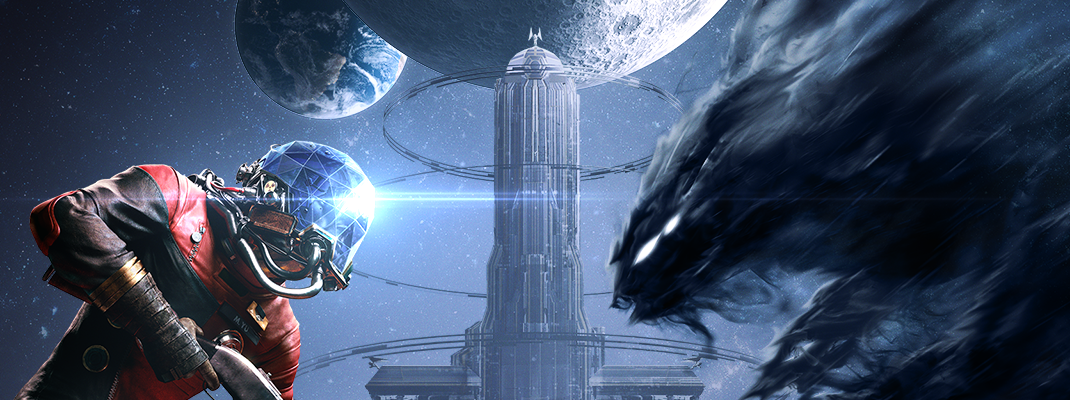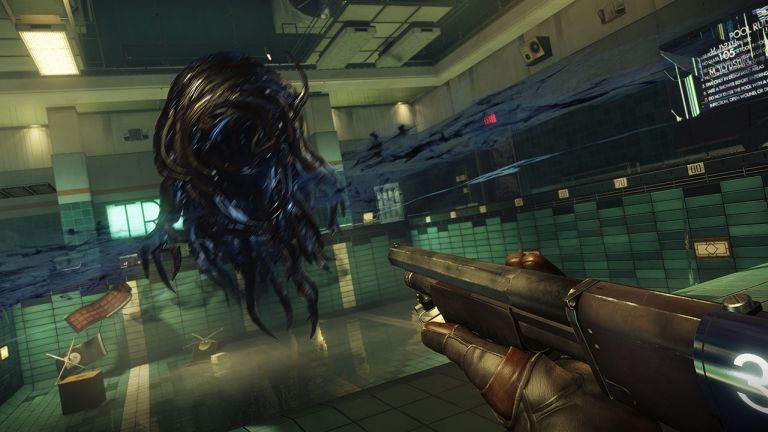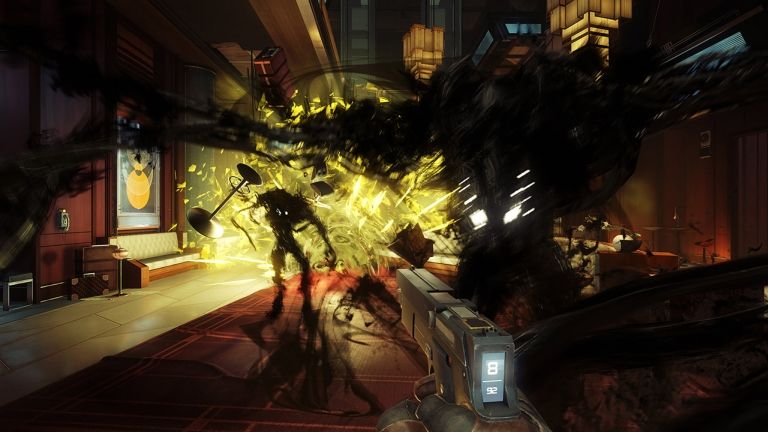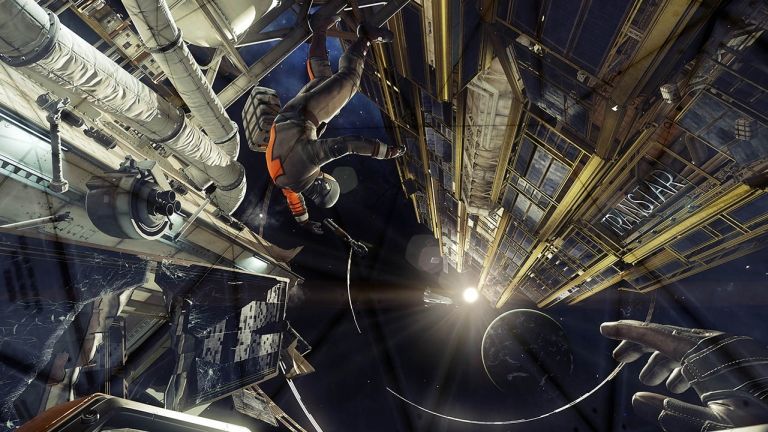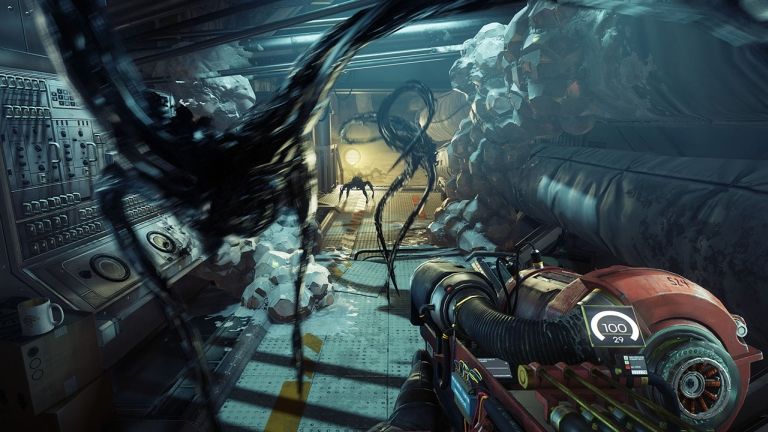I have fond memories of the original Prey from 2006. 3D Realms' seventh-gen shooter was the first ever FPS I had truly beaten from beginning to end, and while that may arguably be owed to the Death World allowing for countless recoveries, it still featured a simple and crass yet fun tale about a Native American reluctantly becoming Earth's savior while battling through several cool levels and blasting away unique alien designs, and it also provided me with the confidence needed to tackle other shooters as well. And thus, over a decade later, we come to the 2017 overhaul of Prey. One that's in-name only, true, but I was still hyped to test how far my skills had come with Arkane's new take on things. And in the end, after helping player character Morgan Yu deal with the alien threat aboard the Talos I space station and getting the good ending, I walked away somewhat satisfied...but also kind of wishing that I had Prey 2 - or even the original game again - instead of this.
I'm going to state right up front that Prey is an incredibly tricky game to review and score. If you were to ask me whether or not I had liked the game and if I could recommend it, I'd say yes on both counts. But if you were to ask me what Prey's unique selling point was, what made for its most memorable level/story element/etc, or about anything specific that made the game worth purchasing, my reaction would be something more akin to a long and confused "Eeeeehhhhhhhhh...?" That's because Prey exists as more of a Frankenstein's monster of past video games and less something wholly original. So the best way to give it a proper analysis, it seems, is to go over the games it owes to and see how it does in each area.
Let's start with the basic setup and premise, which is a rather big elephant in the room. Stop if you've heard this one before: You awake with amnesia and find yourself wandering into a large, ruined sci-fi habitat set it an alternate timeline resulting in retro-futuristic aesthetics everywhere, where your first act is to grab a wrench as an improvised weapon and follow instructions given via a stranger's voice over the radio, reassuring that they know what's best and telling you to do such things as jab yourself full of needles filled with strange drugs in order to give you enhanced abilities while you attempt to piece together exactly what happened that led to the massacre in this otherwise seemingly utopian place, piecing it together from audio logs picked up around dead bodies and the like. Why, hello, BioShock!
Yes, Irrational Games' legendary FPS makes up the heftiest chunks of meat in Prey's body, right down to rummaging through trash bins for supplies and the randomized hacking minigames you can perform on all sorts of machinery that feels clunky and seems to have the occasional impossible solution. But in terms of creating a powerful narrative on par with that seen in Rapture, Prey sadly falls a bit flat. Part of that seems to be because actual living characters and sidequests that pay off in emotional moments don't appear until well into the second half of things, making it tough to get invested for quite a while. And another part is that a lot of the characters just don't feel that interesting. Morgan has more than a few intriguing secrets to learn about them as you investigate their place of power, but his story doesn't contain any twists and turns you haven't seen done better elsewhere (and without any spoilers, don't get me started on the ending to their saga, which I'm actually pissed at in retrospect).
But in terms of crafting a gorgeous-looking world with an eye-catching style and '60s twists amongst the mad science, Prey does come close to being Rapture's equal, for the most part. The best parts of it - in terms of gameplay as well, actually - come after you finish fixing the main lift in Talos I, which creates a more open world that you can travel in and allows you to explore lush arboretums, the inner workings of the company's sales offices, crew lounges where tabletop games are played, and more. Places like these swimming with interesting details and everyday life contrasted among constant blood-stained walls and dark, ominous alien foes makes for an enjoyable journey. Less so when the the plot requires that you be locked in a succession of cargo bays, power plants, and other inner workings that feels like stock FPS settings for several straight hours. They still look good on a technical level, mind you, they just don't play up to the game's strengths.
But getting away from BioShock, the next game that springs to mind, oddly enough, is Alan Wake. Largely because the Typhon, Prey's race of alien antagonists, have a lot of enemies that tend to be born out of possessing humans and having them eerily repeat phrases that they were saying while alive, all while a form of dark energy is oozing out from them. Or in this case, they're nothing but dark energy. Prey does indeed have some impressive enemy designs, ranging from the different varieties of hulking, intimidating humanoid Phantoms that act as tougher foes to the almost Lovecraftian Technopath and Telepaths, massive mounds of seemingly nothing but tendrils that float in the air and control nearby humans and machines. And then, of course, we have the Mimics, the spider-like main foes that dart around and hide by impersonating nearby objects.
I guess you can try and argue that the Mimics are supposed to be the signature part of Prey, but they honestly fell a bit short of that, in this writer's opinion. That's largely because now we've headed into the section where games such as Alien: Isolation and Dead Space have gotten involved, where a lot rides on creating a successful, incredibly spooky sci-fi atmosphere coming from being trapped in the cold depths of space. Now, I don't want to feel like I'm throwing shade at my fellow games journalists or anything, but ever since Prey's release, I've seen several impressions about how the game marvelously creates a world of paranoia, one where you look around every corner nervously and constantly sweat, knowing that any random object could yield a bringer of death. I did notice that most of those articles had played either the one-hour demo or the first few hours of the full game, though. Then after getting past those first few hours myself, I came across the Psychoscope as part of the story, which can mark and scan enemies (so may as well throw in Far Cry 3 or other such shooters as well)...and that also had a chip that revealed hidden Mimics.
Yeah, the terror sort of went downhill from that point onward. Not just because of being able to scan for Mimics (though not Greater Mimics, which still took me by surprise), but rather because of the classic problem more action-oriented horror games like this can run into: The further you advance, the more you gain and learn, then the more powerful you become, and the less of a threat the enemies that once terrified you pose. That's not to say that things aren't still creepy, with the enemies still being foreboding and the various crashes and clanks of the Talos I as it crumbles creating a nice sense of dread, but in terms of scariness in confrontations and FPS combat, things went from "GAAAHHHH RUNAWAYRUNAWAYRUNAWAY OH CRAP AM I ABLE TO IMMOBILIZE IT GAAHHH" to "Oh geez, not these assholes again, now I need to waste ammo dealing with them" quicker than expected.
Speaking of gameplay, we may as well bring Arkane's previous title, Dishonored, in now as well. Actually, we may well gather every first-person Bethesda game, with huge areas that encourage not only exploration, but for the player to uncover multiple solutions to their current dilemmas. And Prey does nicely offer a multitude of ways to approach things, which I definitely admire. The only downside is that while things are set up so that you can take any one route and still come across every major weapon, fabrication plan, stashes of ability-granting Neuromods and more, it does mean that you can excitedly hack into a computer only to discover the third duplicate of plans for the weapon that you already have. Maybe some more unique items a la the Fallout series would help, but that niggle aside, the game's combat, stealth, and general exploration elements all work perfectly fine.
That being said, let's talk for a moment about the Neuromods, your standard source of fuel for upgrades that enhance health, allow you to hack more stuff, make you move faster, your usual lot. After picking up the previously-mentioned Psychoscope, alien Neuromods suddenly became available with psychic abilities and such, but I was warned that taking too many of them would lead me to become less human. This led me to audibly groan, as I had smelled another dual-morality system in play that led to the good and bad endings. I was admittedly wrong, as it turns out that the ending is influenced by certain choices you make and sidequests you take instead, but it was also revealed that having too many alien abilities would cause turrets to turn on you and a Nemesis-style hulking Typhon called the Nightmare to hunt you at times. Fair enough. So with over two dozen of these particular abilities available, how many does it take for these drawbacks to be triggered?
Only two abilities for the turrets. And three for the Nightmare.
Really? That little? I mean, there has to be a risk/reward aspect, sure, but why couldn't those drawbacks be spaced out a bit more? Arkane, what is it with you teasing us with a bunch of cool abilities in your games and then punishing us if we dare to use them? So with no desire to use the more exotic enhancements, I stuck to the human upgrades and made it through just fine...and then the game seemingly bugged out and started summoning the Nightmare anyway, even giving me a side mission related to it that was apparently only meant for those with Typhon-based abilities. I felt like I was being punished for not picking the upgrades that would punish me.
By this point, it may sound like I've mentioned enough issues to have a negative opinion of Prey, but it really does do a lot of things right as well. It has one of the most genuinely fun crafting systems I've seen in any modern game, the weapons are all enjoyable to use in combat (with the GLOO gun being highly satisfying for both creating strategic attacks and reaching new areas), and for the second year in a row, Mick Gordon knocks it out of the park with an amazing soundtrack (yeah, may as well include a slight bit of Doom) that nicely uses dark, ominous synth sounds to the fullest, along with some catchy upbeat '80s stuff for completed missions and calmer moments. There is a large chunk of fun to be had here, it's just that the game never really excels in any area, and even wildly alternates at times between genuine fun and sections of tedium (looking at you, spacewalk segments). Frankly, it could have benefited from actually including the original Prey as one of its parts.
Closing Comments:
Overall, Prey is a fun game with its highlights rooted in beautiful yet creepy levels that contain a lot to explore, but its lack of originality sadly holds it back quite a bit. It's a classic case of "jack of all trades, master of none," except with a couple of flaws in some of its trades as well. It's a lengthy beast that still provides a lot to check out and has a generous amount of well-crafted action, so Prey still may be worth checking out for some, but it's one of the lesser works from an otherwise amazing developer and publisher. Maybe it would have done better if it had a few anus portals like in the original game as well. At least those were memorable...
Prey
Reviewed on PlayStation 4

